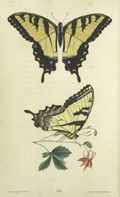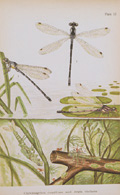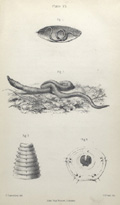|
New York City’s tiniest visible neighbors, mostly
insects, often escape notice. Of the approximately one million
insect and related arthropod species known worldwide, 100,000
are native to North America, where species of dragonflies
and damselflies alone number some 450 (from the world’s approximately
5,000 known species). Because of such overwhelming numbers,
not even skilled entomologists can pinpoint exactly how many
species are to be found within the city. The small selection
here includes only benign, or harmless, or, to indulge in
anthropomorphism, "good" insects; cockroaches, lice, bedbugs,
and other unpopular creatures are dealt with elsewhere. Some
of these tiny neighbors are well known, such as the Honey
Bee, Praying Mantis, "Ladybug," Widow Skimmer dragonfly, and
earthworm; others, such as the preadatory ichneumon wasp Megarrhysa
lunator, will be unfamiliar to many.
Although there are approximately 300,000 known
beetle species worldwide, more than twice as many as the approximately
125,000 lepidoptera (butterfly and moth) species, illustrated
books on the latter easily outnumber those devoted to beetles,
and so lepidoptera predominate in this section. The reasons
are simple – eye-catching wing colors and patterns, larger
size, and the fluttery flight of many of these insects make
them more likely to be noticed and studied, by both casual
observers and enthusiasts. Zoological artists through the
centuries have also been attracted to butterflies and moths,
and have documented them in sumptuously illustrated entomologies
of the first rank.
Check out the sighting
log to record your interaction with some of the native
New York City wildlife featured in Urban Neighbors.
You may also browse the sighting log by animal, borough, park
or natural area, and/or habitat to view a sighting you have
submitted or to read others’ observations.
|
1

Eastern Tiger Swallowtail/
NYPL
2

Ailanthus Silkmoth / NYPL
3

Cecropia Silkmoth / NYPL
4

Damselflies / NYPL
5

Common
Earthworm / NYPL
|






